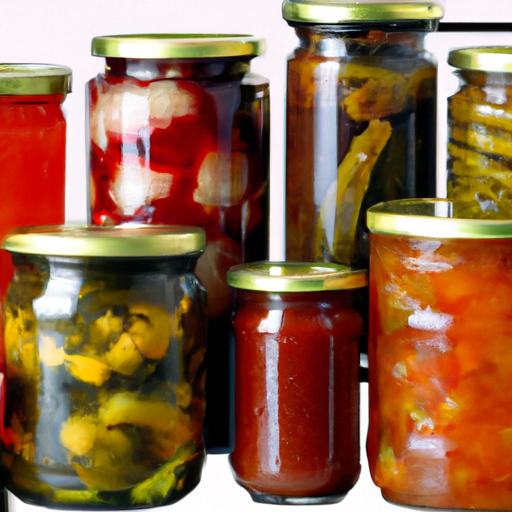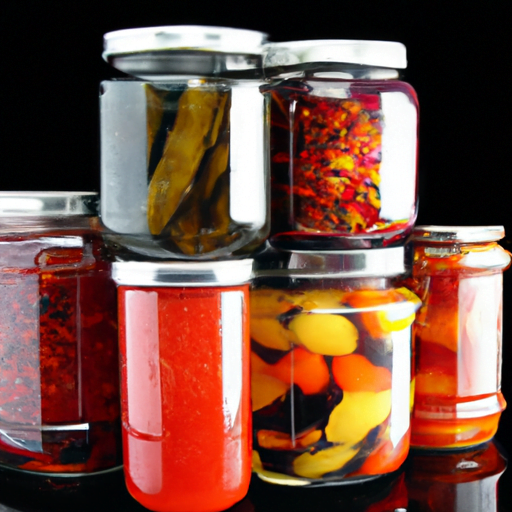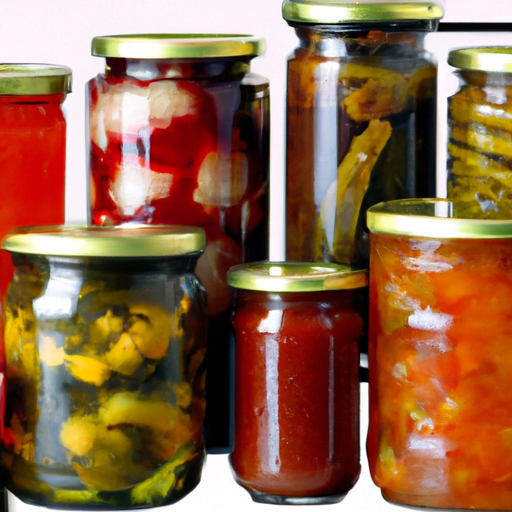So, you’re interested in off-grid living and want to know how to preserve your food at room temperature? Well, you’ve come to the right place! Preserving food without the need for refrigeration or freezing can be a real game-changer, whether you’re living off the grid or simply looking to reduce your reliance on modern appliances. In this article, we’re going to dive deep into the ultimate guide to preserving food at room temperature, providing you with practical tips and techniques to help you store food safely and enjoy it for longer periods of time. So, let’s get started!
Preserving food at room temperature may sound a bit counterintuitive, especially when we’ve been taught to rely on refrigeration for keeping our food fresh. However, many cultures have been preserving food at room temperature for centuries, using techniques such as canning, drying, fermenting, and pickling. These methods not only help to extend the shelf life of various food items, but they also add unique flavors and textures to the preserved foods.
Throughout this guide, we’ll explore each preservation method in detail, discussing the benefits, equipment needed, and step-by-step instructions for preserving different types of food. From canning fruits and vegetables to drying herbs and meats, you’ll learn everything you need to know to get started on your own off-grid food preservation journey. So, if you’re ready to discover the wonderful world of preserving food at room temperature, keep reading our article and get ready to take your culinary skills to the next level!

The Ultimate Guide to Preserving Food at Room Temperature
Off grid living or simply wanting to reduce food waste, there are plenty of reasons why preserving food at room temperature is beneficial. Whether you are interested in canning, dehydrating, salting, smoking, or pickling, these methods can help extend the shelf life of your food and reduce the need for refrigeration. In this ultimate guide, we will explore the importance of food preservation, discuss various methods of preservation, and provide tips for ensuring safety in room temperature food preservation.
Why Food Preservation is Necessary
Food preservation is crucial for several reasons. Firstly, it helps to prevent food spoilage, which can occur due to the growth of microorganisms such as bacteria, fungi, and yeast. These microorganisms thrive in warm and moist environments, causing food to deteriorate quickly. By preserving food, you can inhibit their growth and extend the shelf life of your groceries.
Secondly, food preservation allows for year-round availability of certain foods. Seasonal fruits and vegetables can be preserved at their peak freshness so that you can enjoy them even during the off-season. Additionally, it can help save money by preventing food waste and allowing you to take advantage of sales or bulk purchases.
Lastly, preserving food at room temperature can be a practical solution for off grid living or in areas where access to electricity or refrigeration is limited. It provides an alternative way to store food without the need for constant cooling, which can be especially beneficial in emergency situations or during power outages.
Benefits of Preserving Food at Room Temperature
Preserving food at room temperature offers several advantages. For starters, it eliminates the need for refrigeration or freezing, which can save energy and reduce electricity bills. It also frees up valuable space in your refrigerator or freezer for other items.
Another benefit is that room temperature preserved foods often retain more of their natural flavors and textures compared to those processed with intensive heating or freezing methods. This is especially noticeable in fruits and vegetables, where their vibrant colors, crispness, and sweetness can be better preserved through room temperature techniques.
Moreover, preserved food at room temperature can be more convenient. You can easily store them on your kitchen shelves, pantry, or root cellar, allowing for easy access and quick meal preparation. No need to defrost or wait for food to reach the desired temperature – it’s ready to use whenever you need it.
Methods of Food Preservation
Now that we understand the importance and benefits of food preservation at room temperature, let’s dive into some popular methods you can utilize.
Canning
Canning is a widely used method of food preservation that involves sealing food in airtight containers like glass jars or cans. The process of canning helps to destroy microorganisms, such as bacteria and yeast, by using heat and creating a vacuum seal. This inhibits their growth, preventing spoilage and extending the shelf life of the preserved food.
The process of canning typically involves heating the food to a specific temperature, placing it in sterilized jars, sealing the jars, and then process them in a boiling water bath. This method is suitable for a variety of foods, including fruits, vegetables, jams, jellies, sauces, and even meat or poultry when done using pressure canners.
To start canning, you will need specific equipment such as canning jars with lids and bands, a canner or large pot, a jar lifter, a canning funnel, and a tool for removing air bubbles. It is important to follow proper canning procedures to ensure the preservation is safe and effective.
Dehydrating
Dehydrating is a method of removing moisture from food, which inhibits the growth of microorganisms. This preservation method involves significantly reducing the water content of foods, typically using a low heat source or a dehydrator. The process can take several hours or even days, depending on the food and the method used.
Fruits and vegetables are commonly dehydrated to preserve their flavors and nutritional value. Once dehydrated, the food becomes lightweight and compact, making it easier to store and transport. Dehydrated foods can be enjoyed as is, or rehydrated by soaking them in water before use, depending on your preference.
When dehydrating food at home, an electric dehydrator is often the most efficient and convenient option. It provides consistent heat and airflow to evenly dry the food, resulting in optimal preservation. However, you can also use your oven or sun-drying methods if an electric dehydrator is not available.
Salting
Salt has been used as a preservative for centuries due to its ability to draw out moisture from food and create an environment that inhibits the growth of bacteria and other microorganisms. There are two primary methods of salting food for preservation: dry salting and wet salting.
Dry salting involves coating the food, typically meat or fish, with a generous amount of salt and letting it sit uncovered in a cool and dry place. The salt draws out the moisture from the food, thereby inhibiting the growth of bacteria and preventing spoilage. Once the desired level of dehydration is achieved, the food can be stored in airtight containers or vacuum-sealed bags.
On the other hand, wet salting requires submerging the food in a brine solution made of salt and water. The brine acts as a preservative by creating an environment that is inhospitable to bacteria. This method is commonly used for preserving vegetables, such as cucumbers in pickling.
When salting food, it is important to use the right amount of salt to ensure proper preservation. Too little salt may not be effective, while too much salt can make the food overly salty and unpleasant to consume. Additionally, proper sanitation and cleanliness are essential in the salting process to prevent the growth of harmful bacteria.
Smoking
Smoking is an ancient preservation technique that not only preserves food but also imparts a rich and smoky flavor to it. The process involves exposing food to smoke generated by burning wood or other aromatic materials. The smoke acts as both a preservative and a flavor enhancer.
The smoking process helps to inhibit the growth of bacteria, yeast, and molds by creating an acidic environment and by drying out the food. Smoke also contains antimicrobial properties that add an extra layer of protection against spoilage.
Different smoking techniques can be used, such as cold smoking, hot smoking, or a combination of both. Cold smoking involves exposing the food to smoke while keeping the temperature below 90°F (32°C). Hot smoking, on the other hand, cooks the food as it smokes, with temperatures reaching above 165°F (74°C). The choice of technique depends on the type of food being smoked and the desired outcome.
Choosing the right type of wood is crucial for smoking, as different woods provide different flavors. Some common types of wood used for smoking include hickory, mesquite, applewood, and cherrywood. Experimenting with different wood combinations can result in unique and delicious smoked flavors.
Pickling
Pickling is a preservation method that involves immersing food, usually vegetables or fruit, in an acidic solution such as vinegar or brine. The primary goal of pickling is to create an acidic environment that inhibits the growth of spoilage-causing microorganisms.
There are several pickling methods, including vinegar pickling, fermenting, and salt pickling. Vinegar pickling involves preserving food in a solution of vinegar, water, sugar, and spices. Fermenting, on the other hand, relies on the natural process of lacto-fermentation, where the sugars in the food are converted into lactic acid by beneficial bacteria.
Salt pickling, also known as brine pickling, involves preserving food in a saline solution made of salt and water. This method is commonly used for pickling vegetables, such as cucumbers, cabbage, and onions. The salt helps to draw out the moisture from the vegetables while inhibiting the growth of harmful bacteria.
Pickling not only extends the shelf life of food but also enhances its flavors and textures. The tangy and vinegary taste of pickled foods can add a delightful tang to dishes and provide a refreshing contrast to rich and heavy flavors.

Storage and Shelf Life
Proper storage is essential for maintaining the quality and safety of preserved food. Even though these preservation methods allow food to be stored at room temperature, certain conditions should be followed to maximize shelf life.
Proper Storage Conditions
To ensure the longevity of preserved food, you should store it in a cool, dry, and dark place. Excessive heat can shorten the shelf life of preserved food, while high humidity can lead to mold growth. Direct sunlight can cause color fading and flavor deterioration. Therefore, it is crucial to choose a storage location that meets these criteria.
A pantry, root cellar, or dedicated shelf in a cool room are excellent options for storing preserved food. Make sure the storage area is clean and free from pests to prevent contamination or spoilage. Additionally, always label your preserved items with the date of preparation to keep track of their freshness.
Factors Affecting Shelf Life
The shelf life of preserved food can vary depending on several factors:
Method of Preservation: Each preservation method has its own shelf life. Canned food can last for several years when stored properly, while dehydrated food can maintain its quality for months to years. Pickled food can also have a long shelf life, especially when cured in vinegar. Smoking and salting can extend the shelf life of food but may have shorter preservation times than other methods.
Quality of Ingredients: Using fresh and high-quality ingredients for preservation can prolong the shelf life of the preserved food. Overripe or damaged fruits or vegetables may not preserve well and may spoil quickly.
Storage Conditions: Proper storage conditions, as mentioned earlier, play a significant role in determining the shelf life of preserved food. Ensure that the storage area maintains a stable temperature and humidity level to prevent spoilage.
Sensitivity to Contamination: Proper sanitation is crucial in preventing contamination and maintaining food safety. Always use clean utensils, sterilized jars, and follow hygienic procedures during food preservation.
Common Food Spoilage Signs
Despite your best efforts, it is important to be able to recognize signs of food spoilage to ensure your safety. Some common indicators of spoiled food include:
Mold: Mold growth on preserved food is a clear sign of spoilage. Discard any food showing signs of mold growth.
Off Odor: If the preserved food emits an unpleasant or foul odor, it is likely spoiled and should not be consumed.
Changes in Texture or Appearance: Any noticeable changes in the texture, color, or appearance of the preserved food may indicate spoilage. Look for signs of discoloration, sliminess, or significant changes in texture.
Gas Formation or Bulging: If the jar or container appears swollen or there is gas formation when opened, it is a sign of bacterial growth and should be discarded.
If you encounter any of these signs of spoilage, it is important to err on the side of caution and dispose of the food.
Ensuring Safety in Room Temperature Food Preservation
Food safety is crucial when preserving food at room temperature. Improper handling or contamination can lead to foodborne illnesses, which can be severe or even life-threatening. Here are some important tips to ensure safety in room temperature food preservation:
Importance of Proper Sanitation
Maintaining proper sanitation throughout the food preservation process is crucial to prevent contamination. Always wash your hands thoroughly before handling food, and ensure that all utensils, jars, and equipment are cleaned and sterilized before use.
Follow approved recipes and guidelines to ensure safe preservation practices. Avoid using expired ingredients or reusing containers without proper cleaning. Additionally, make sure to label your preserved items with the preparation date for easy tracking and identification.
Understanding Foodborne Illnesses
Educating yourself about common foodborne illnesses is key to safe food preservation. Familiarize yourself with the symptoms and risks associated with various pathogens such as E. coli, Salmonella, or botulism. Take necessary precautions to prevent the growth and spread of these harmful bacteria during the preservation process.
Tips for Safe Food Preservation
Use Reliable Sources: When following recipes or guidelines for room temperature food preservation, ensure that you are using reliable and trusted sources. Government resources, reputable books, or reputable websites can provide accurate and up-to-date information.
Follow Proper Procedures: Each preservation method requires specific procedures to ensure safety and effectiveness. Follow these procedures closely to avoid risks of spoilage or contamination.
Temperature Control: Maintain a stable room temperature storage area, as fluctuating temperatures can lead to microbial growth. If you live in a hot climate, consider using a temperature-controlled space or employing techniques such as root cellaring to ensure optimal storage conditions.
Regularly Inspect Preserved Food: Regularly inspect your preserved food for signs of spoilage. If in doubt, it is best to err on the side of caution and dispose of questionable items.
Conclusion
Preserving food at room temperature offers a multitude of benefits, from reducing food waste to saving energy and ensuring year-round availability of certain foods. By utilizing canning, dehydrating, salting, smoking, or pickling methods, you can extend the shelf life of your food while enjoying their natural flavors and textures.
Remember to follow proper procedures, maintain good sanitation practices, and regularly inspect your preserved food for signs of spoilage. With careful attention to detail and proper storage conditions, you can confidently preserve your food at room temperature and enjoy the fruits of your labor for months or even years to come.




